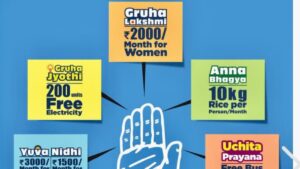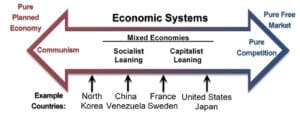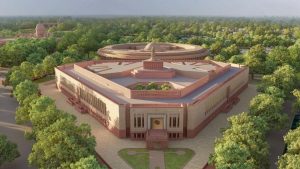18 mins read
Last Updated on February 9, 2025
Resize the Font:
- Intro
- 3 Lakh rupees vs 12 Lakh rupees?
- Consumption is down
- Manufacturing sector is down
- Government not to be blamed for the slowdown in manufacturing
- The claimed boost to consumption and GDP
- Demand-side economics is the short-term fix
- Employment-led consumption is the long-term solution
- Appealing to middle-class before the Delhi election
- Conclusion
Intro
By now, you might have seen the news about Finance Minister Sitharaman presenting the budget on February 1st for the financial year 2025-26. This has been her record eighth budget. But, this was not any interim budget like last year, becuase last year had general election. The last year’s full budget had to be presented again on July 23, 2024, after the general elections.
Did you know there is a tradition that is followed every year before the final preparation of the Budget, 9-10 days prior to the Union Budget presentation? The Finance Minister personally stirs a large ‘kadhai’ (vessel) of halwa. Halwa is sweet. But, nothing has ever been more sweet to the middle class than the budget itself.
I guess the middle-class uproar on media has finally come to fruition. We started to see this discussion when the union government raised taxes on long-term and short-term capital gains in last year’s budget. Then, a few months before the presentation of this year’s budget, there was a discussion on social media about tax cuts for incomes up to 15 Lakhs. Who knew it would really happen? Of course, except the FM herself?
3 Lakh rupees vs 12 Lakh rupees?
Does anyone think that a person with 3 Lakh rupees income has the same level of disposal income as that of the person with 12 Lakh rupees income?
Before this tax cut, we could have made the same comparison between the people who earn 3 Lakhs vs the people who earn 7 Lakhs. But, 7 Lakhs is just a little over more than twice the 3 Lakhs. On the other hand, 12 Lakhs is four times the 3 Lakhs. One person’s 12 Lakh income is equivalent to the combined income of 4 families of 3 Lakh rupees income.
Ask yourself these questions…..Can a person earning 3 Lakh rupees afford to buy a house in any metro city? Can a person earning 3 Lakh rupees afford to go on a trip to Switzerland? Can a person earning 3 Lakh rupees afford to send their kids to top private schools in the city?
Here is where I draw the line. Here is where it becomes the comparison like the one between, you know, apples and oranges.
We have to look at apples and oranges for what they are instead of confusing one for the other.
I am not saying that there should not be any tax relief for those who are making upto 12 Lakhs. I am saying if there is tax relief for people whose income is between 7 and 12 Lakhs, there should also be something for people whose income is less than 7 Lakhs. Unlike 12 Lakh income earners, these people need more than just tax relief.
In the long run, I would prefer the rising living costs to be addressed for everyone, especially education and healthcare. This would save a lot more than any tax relief or any direct cash transfer schemes could.
Consumption is down
The consumption has gone down from 58.1% of GDP in FY22 to 55.8% in FY24. This is an overall trend. If we can look at specific sectors, we will see more clearly.
Here is what Rakesh Sharma, executive director at Bajaj Auto Ltd., had to say:
“The motorcycle industry is almost flattish with 1 per cent to 2 per cent growth only. We had thought that it would be upwards of 5 per cent-6 per cent,” Rakesh Sharma, executive director at Bajaj Auto Ltd., said in an Oct. 16 post-earnings call.
The FMCG sector is not doing great either. At least seven of India’s largest companies, including Reliance Industries Ltd.’s retail arm and consumer bellwether Hindustan Unilever Ltd., have flagged softer consumption demand and a challenging operating environment in their earnings for the July to September period.
Sales of small cars, which is seen as an indicator of urban consumer demand, is not growing.
“The cause of concern is that growth is taking place only in certain segments,” R. C. Bhargava, chairman of Maruti Suzuki India Ltd., told reporters on Tuesday after India’s largest carmaker posted underwhelming profit. “What used to be 80% of the market is not growing,” he said
Manufacturing sector is down
Rahul Gandi also made a Speech in the Parliament about the share of the manufacturing sector’s contribution to GDP going down by a few percentage points from 2014-2015 to 2022-2023.
At first, I didn’t believe his numbers, not because he didn’t cite the source of the data. It is because, well….he is a politician. Doesn’t matter whether they are in ruling party or in opposition, it is hard for me to take their words at face value.
So, I looked for the source he was citing. I went to notebooklm.google.com and asked it to fetch the source he was citing and it returned with the following.
An internet search indicates that the statistic is likely from the National Accounts Statistics, published by the Ministry of Statistics and Programme Implementation (MoSPI), Government of India, specifically the Gross Domestic Product (GDP) data.
It appears that Rahul Gandhi was referring to the share of the **Manufacturing Sector in Gross Value Added (GVA) at current prices. According to data available from MoSPI, the manufacturing sector's share of the GVA was approximately:
* 15.3% in 2014-2015
* 12.6% in 2022-2023So, I went to google.com and searched for the data from MoSPI on Manufacturing sector’s share in contribution to GDP.
So, I went to google.com and searched for the data from MoSPI on the Manufacturing sector’s share in contribution to GDP. I was able to verify the data in two PDFs from MoSPI: PDF1 and PDF2.
Hoowever, I found that it was not since 2014, Manufacturing sector’s contribution to GDP has been falling. It had been falling even before 2014. If you look at the chart on the World Bank website, you will see it has been falling since 2010, when the contribution was at 17% . Here is the chart on their website since 1968: click here.
I could not able to find any data from the MoSPI website that verified that manufacturing sector’s share in GDP was at 17% in 2010.
Government not to be blamed for the slowdown in manufacturing
We can hardly blame the government for that. The government did whatever it could to promote the manufacturing sector by allocating close to 2 Lakh crore rupees with the Production-Linked Incentive(PLI) Scheme.
Data shows that the fund utilisation was less than 10 percent of the Rs 1.97 lakh crore that has been allocated since inception until the end of CY24. This is pushing the ministries to focus on more targeted interventions based on market demand, rather than applying the same PLI framework across all sectors.
In order to promote growth and investment, a new provision has been inserted in the Income-tax Act with effect from FY 2019-20 which allows any domestic company an option to pay income-tax at the rate of 22% subject to condition that they will not avail any exemption/incentive. The effective tax rate for these companies shall be 25.17% inclusive of surcharge & cess. Also, such companies shall not be required to pay Minimum Alternate Tax.
In order to attract fresh investment in manufacturing and thereby provide boost to ‘Make-in-India’ initiative of the Government, another new provision has been inserted in the Income-tax Act with effect from FY 2019-20 which allows any new domestic company incorporated on or after 1st October 2019 making fresh investment in manufacturing, an option to pay income-tax at the rate of 15%.
These measures – Corporate tax cut and PLI Scheme tell you one thing clearly. The supply-side economics aka trickle-down economics didn’t work. Now, the government is altering its stance to include a consumption-led approach to promote manufacturing.
There are many reasons behind manufacturing doing not so well right now. One giant reason obviously is China. We cannot ignore the competition coming from China. No manufacturing company can. Manufacturing has become a global battle with globalization.
Tariffs and caps can only take you so far. After some point, we need to have a competitive edge that puts domestic companies ahead of foreign companies, not just in domestic markets but also in foreign markets. Competitive edge could be in the form of natural resources, investments, labor cost, or skill set.
Except for skill set, everything else is subject to the global market and availability of natural resources. To some extent, skill set is also subject to the global market. But, at least, we can be in charge of educating and skilling our youth, which is less affected by the global market.
If one thing the government can do is to invest more on training and skilling the youth, the other thing they can do is phasing out the corporate tax cut. This tax cut came out in 2019 and it has been six years now. We haven’t seen much private investment since then. It comes at a huge cost to have this tax cut. As the government states, it costs 1,45,000 crore rupees every year. If the corporations don’t reinvest and create jobs or increase productivity, there is no point in having this tax cut.
The claimed boost to consumption and GDP
The sectors that might see an increase in consumption are as follows:
Automobile Sector
Two-wheelers
Passenger vehicles
Consumer Durables
White Goods
Electronics
Home Improvement
Real Estate (through improved EMI capabilities)
But the question is how much? By how much the consumption will rise?
Economists like KV Subramanian predict that the tax cut will:
KV Subramanian, Executive Director, IMF, says the finance minister stated that tax cuts will put around Rs 1 lakh crore in the hands of the middle class. Middle class savings are roughly 18%, and if we round it to 20%, it suggests that 80% of this amount will be spent. The consumption multiplier, which is the inverse of the savings rate, is about five. Therefore, we can anticipate a total increase in consumption of around Rs 5 lakh crore, which represents about 2.7% of GDP. The GDP growth estimate is at 6.3% on the lower end. Adding that 2.7% could bring the total to 9%, and even with some overestimation, a growth rate near 8%, definitely above 7%.
Saurabh Mukherjea offers a more conservative prediction:
I think the multiplier associated with a tax cut will be modest, say around 1.1. However, because the amount involved in the tax cut is so modest, even if I factor in a multiplier it is hard to see FY26 GDP growth being boosted by more than 0.25%. For consumption to recover in a more significant way we need the job creation cycle to kick into life.
Here are the official figures by FM Nirmala Sitharaman herself:
India’s economy is expected to grow between 6.3% and 6.8% in FY26, per the Economic Survey tabled in Parliament by Union Minister for Finance and Corporate Affairs, Ms. Nirmala Sitharaman, on January 26, 2025. This aligns with growth forecasts by international bodies such as the International Monetary Fund (IMF), Asian Development Bank (ADB), and World Bank. The IMF has kept India’s GDP growth projection at 6.5% for FY25 and FY26, while the World Bank anticipates a 6.7% growth. The ADB revised India’s GDP forecast for FY25 to 6.5% from 7%; for FY26, it revised the projection to 7% from 7.2%. These adjustments reflect weaker-than-expected growth in Q2 FY25, primarily due to manufacturing and government spending slowdowns.
The projected GDP growth rate for the next year is 6.8%. If the multiplier effect is as high as KV Subramanian says it will be, then the projected GDP growth rate would be higher than that. Both KV Subramanian and Saurabh Mukherjea can’t be right here with their projection for the GDP growth rate. One says it will be 8% and the other says only 0.25% increase in the GDP, which is not even 7%. But, personally, I would not bet against the government which has projected the GDP growth at 6.8%.
This is also not going to boost the FMCG sector. We saw that the FMCG sector is down in the section “consumption is down“. People earning between 7 lakh and 12 rupees might buy more home and kitchen appliances or even go for a motorbike or car. But, they are not going to buy more soaps because of this tax relief.
Demand-side economics is the short-term fix
Tax collected by the Centre from petroleum as excise duty was Rs 1.22 trillion during the first six months (April-September) of FY25. This is less than half of the Rs 2.73 trillion collected for the full FY24, data from the Petroleum and Natural Gas Ministry submitted to Parliament last week showed.
Fuel tax collection amounted to 2.73 Lakh crore rupees. If the government kept this 1 Lakh rupees with itself, it could have reallocated and lowered the fuel tax. It could have brought down the fuel tax by more than 33% – 1 Lakh crore rupees is more than a third of 2.73 lakh crore rupees.
Excise duty charged by the Central Government on Petrol is ₹19.90 per liter. By charging 2/3rd the rate at which it is charging now, the government could have saved a minimum of 6-8 rupees for every liter of petrol.
GST on Essential commodities like packaged food items, milk, curd, etc could have been abolished as it was not there before the GST was introduced. This would have saved another 5% for everyone.
You kill two birds with one stone with this approach. With prices of fuel and essential commodities going down, you will surely increase the consumption, but also you will address the inflation.
With inflation going down, the RBI can quickly cut the rates. That would in turn make the cost of financing businesses lower.
Demand-side economics, whether it is tax cuts or welfare schemes, comes with limitations. We can only have so many of these measures without raising the debt level.
Employment-led consumption is the long-term solution
I am sure the government wanted to create more jobs with Corporate tax cuts and PLI schemes in the long run. But, unfortunately, it didn’t happen.
It is not like the government didn’t realize this. The government knew very well about this that’s why they came up with another scheme that promotes employment creation directly – Employment-Linked Incentive(ELI) in the July 2024 Budget.
ELI has 3 schemes in it. I have copy-pasted the exact text from The Press Information Bureau (PIB) of the Union Government:
Scheme A: First Timers
The direct benefit transfer of one-month salary in 3 instalments to first-time employees, as registered in the EPFO, will be up to 15,000. The eligibility limit will be a salary of 1 lakh per month. “The scheme is expected to benefit 210 lakh youth”, she said.
Scheme B: Job Creation in manufacturing
An incentive will be provided at specified scale directly both to the employee and the employer with respect to their EPFO contribution in the first 4 years of employment. Smt. Nirmala Sitharaman stated that the scheme is expected to benefit 30 lakh youth entering employment and their employers.
Scheme C: Support to employers
All additional employment within a salary of "1 lakh per month will be counted. The Government will reimburse to employers up to ` 3,000 per month for 2 years towards their EPFO contribution for each additional employee. “The scheme is expected to incentivize additional employment of 50 lakh persons”, she added.Unfortunately, while announcing this year’s budget on Feb 1, 2025, the government hasn’t released any data on the performance of these schemes since their announcement last July. So, we are not sure how well they have done.
One can’t help but think that if they did so well, wouldn’t the government love to talk about them? The government would also encourage these schemes more by allocating more budget if they did really work. I take it that they haven’t done so well or at least, not as well as the government can brag about it.
But, this is still a step in the right direction. The government realized that both corporate tax cuts and PLI were not working. Private investment didn’t come through because existing manufacturing units are running at under-capacity. Why would anyone spend on expanding production when their existing capacity is underutilized? So, The government realized this and they decided to change something to boost employment and ultimately, the GDP.
Now, with tax relief to people earning up to 12 Lakh rupees, the government abandoned this approach completely. This tax relief leading to more savings in the hands of people is not going to create more jobs. For sure, It has the potential to increase the consumption. But, does it increase consumption so much that it will create more jobs as well? I am not sure about that. This is because 1 Lak crores is not even 3 percent of our GDP(35 Lakh crores).
Another supporting data point is the government’s estimate of the GDP growth rate for the next year is only 6.8, not very high either. We know that we can have jobless growth when all the work is being done by more machines than humans. But can we increase employment without the rise in GDP? Well, we cannot, or….we can as well. We can when more people are doing one person’s job. Even then, that one person job need to be created for the multiple people to occupy it. So, there will always be a productivity boost. It might not be proportionate to the rise in employment generation.
If the government had taken the same approach as they did with ELI when they announced it, the Government would’ve doubled down on employment generation and spent this 1 Lakh crore rupees on MGNREGA. By adding more days to work, the government could have not only addressed unemployment more effectively but also spent the money on people who would buy things from the market right away, stimulating consumption.
People who depend on this scheme might not buy a car, but they would definitely buy a bike or at least, a second-hand one. If not a bike, they would absolutely spend it on essentials like – soaps. We could have seen that the FMCG sector doing well again.
Appealing to middle-class before the Delhi election
Now that the election results are out and the BJP has won a comfortable majority, it is easy to say that the BJP announced this tax cut to appeal to the middle class in Delhi. BJP might or might have not done this with the election in mind. We will never know the truth for sure.
If you think about it, one of the strongest partners in the I.N.D.I. alliance is AAP. If the BJP is successful in sowing the seeds of animosity between Congress and AAP, BJP definitely has the upper hand in beating the opposition forever. Or, the AAP might get so weak in the future that it might join hands with the BJP, or party members might jump ship and join the BJP altogether like many who have done it already. I.N.D.I. alliance getting weaker or AAP getting weaker, either way, BJP always stands to gain.
We can never rule this out. Every party thinks about the consolidation of the voter base with their schemes and policies. This tax relief could definitely be one of them.
Conclusion
Budget is all about balancing, where total revenues are equal to total expenses, making sure that spending does not exceed income.
Budget is also balancing everyone’s needs – producer and consumer, employer and employee, upper, middle, and lower classes, and poor and poorest of poor.
If the middle class is hurting, what should we say about any class lower than that?
BJP’s strong vote base is in urban cities and towns. I guess it didn’t want to let their concerns go unheard. These urban voters are more likely to be middle class. Or, It could just be sending out the message that it is pro-middle class or it could be sucking up to people who have money as it did with abolishing the upper tax slab of surcharge tax that applies to people who have income more than 50 lakhs. I am not sure which one or …it could be all.
Another thing, we will never know is the timing of it right before the Delhi Assembly election. It does raise a serious question.
Middle-class has a voice, as told by FM Sitharaman herself in the interview. What happens to people who don’t have a voice? Will the government listen to the voiceless and make the budgets in the coming years to be about them? We will never know. Only time will tell in politics….and the time closer to the election will also tell.
Finally, I would like to leave you with this comment that I found on YouTube video of FM Nirmala Sithraman’s full interview with India Today that pretty much sums up the mindset of this middle-class that raised their voice a few months ago to get this tax relief:
Thank you so much for hearing and acknowledging the voice of 90 lacs tax payers, who are economic soldiers of the country, carried the burden of 140 cr people for decades.
That was very creative. I didn’t know you could insult both soldiers and others who are not in this 90 lacs but pay GST all the time in the same sentence.
Thank you for making it all the way to the end. Check out my other posts below.




